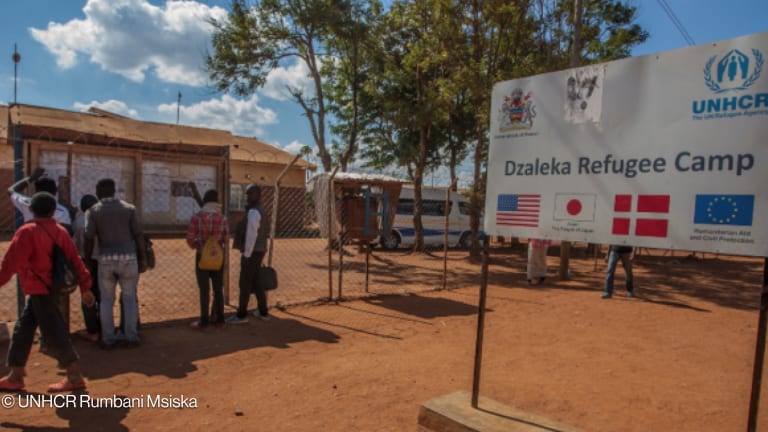Lessons on learning: Providing education in crises
Education’s importance in crises cannot be stressed enough, as it helps displaced children and young people gain stability and security. Devex explores some of the best ways to bring learning to the toughest classrooms and contexts in the world.
There are more refugees and displaced people in the world today than ever recorded, and more than half of them are children. For them, and for millions more living in conflict-ridden and fragile states, education is often their only protection against becoming a lost generation, unable to bounce back from adversity without any employment prospects or a secure place in society. The value of education is widely recognized and understood among aid workers, world leaders and refugees themselves, but in crisis situations, the sector is the most underfunded, receiving only 2 percent of humanitarian aid in 2014. As a result, 65 million children caught in conflict or crisis are out of school or at risk of dropping out, and according to the Overseas Development Institute, the world needs an annual $4.8 billion more to ensure that no child really is left behind. “It’s an issue of increasing numbers in a context where we are faced with decreasing funding levels,” Barbara Zeus, education specialist at the Office of the U.N. High Commissioner for Refugees, told Devex. The issue did, however, take center stage at the recent Oslo Summit on Education for Development, where there were talks of creating a global humanitarian fund for education in emergencies. The oft-neglected sector has long been searching for a global funding champion to pull it out of its funding slump, and many are optimistic about the European Union leading the way. The 28-member bloc recently pledged 4 percent of its humanitarian aid budget for education for children in emergencies — an action that will hopefully drive other donors to follow suit. In varied contexts, standards are key In education in crisis situations, one size does not fit all — emergencies and protracted crises demand different approaches. And even between emergency situations or between long-standing crises, needs, capacities and interventions can be as varied as the communities and populations affected. In the face of such volatility, maintaining and following a set of standards have become essential to the success of the sector. The Minimum Standards for Education: Preparedness, Response, Recovery — created by the Inter-Agency Network for Education in Emergencies through a highly consultative process involving experts in education and humanitarian aid — lays the foundation for quality education in crisis contexts and provides comprehensive guidelines applicable in a wide range of situations — from disaster response and recovery in Nepal to Syrian refugee education in Lebanon and Jordan. Aside from professionalizing the field and enhancing the quality and accountability of humanitarian and development action, the INEE Minimum Standards exist to ensure that human rights are never overlooked, even in the toughest contexts. The standards also allow education and aid providers to speak the same language — facilitating better coordination, monitoring and evaluation. Getting back on the formal track INEE Director Dean Brooks explained that in every crisis, the goal of the humanitarian education response is to restore — and strengthen — the formal education system that was in operation before the emergency. “I think it’s really important that the Minimum Standards really helps us and guides us to really think about building on what was [there] before the crisis,” he told Devex. “As soon as possible, the idea is to get back into the formal track … sometimes, it’s nonformal [education] until you can get back on to the formal track. But everyone wants a meaningful education that’s recognized, and they want that continuity of education.” But getting back on the formal track involves different stages in education response. According to Sweta Shah, a global education and early childhood care and development in emergencies specialist at Plan International, the days immediately following a disaster typically involve assessment, planning and fundraising. “This is a critical time for donors to also put money toward education so agencies can begin planning support,” she told Devex. Within a month, humanitarian education workers should start providing both formal and nonformal education to children and young people. “We would be looking at establishing temporary learning spaces or ensuring existing schools are safe for children to return to, training teachers, replacing teaching and learning materials that might have been lost, supporting children’s return to school through a back-to-school campaign [and providing] psychosocial support for teachers, children and parents,” Shah said. One year after a disaster, the education sector should typically be in the recovery phase. This means rebuilding and retrofitting schools, and working with the government and ministry of education to develop a longer-term education strategy and make schools more disaster resilient. According to INEE, the focus after the first phases of education response should be “on scaling up as well as on pedagogical issues in order to promote a resumption to quality learning, with additional training for teachers and school managers, provision of textbooks and teaching equipment, as well as revising the curriculum where necessary, to meet the needs of all children and adolescents.” To make the best and biggest impact, and address the holistic needs of the child, the education cluster must also cooperate and collaborate with other humanitarian clusters throughout its response. It can work with the protection cluster to safeguard children from human trafficking, military recruitment, forced marriage, gangs, drugs and other threats; with the camp management cluster, it can create child-friendly spaces that restore a sense of normalcy and stability to children’s lives; with the health, and water, sanitation and hygiene clusters, it can disseminate information on hygiene and health; and with nutrition, it can carry out school feeding programs that target the children most in need. Toward integration, away from parallel systems Many emergencies and refugee situations eventually become protracted, putting millions more children at risk of long-term education disruption. In 2012, the UNHCR recalibrated its education strategy in response to a 2011 report that found that parallel education systems for refugees were less effective in providing quality education for displaced children and young people. “UNHCR’s overall policy is to work toward mainstreaming of refugee children and youth into national education systems rather than pursue the approach of what has been done in the past in terms of creating parallel education systems and parallel structures that are not sustainable,” UNHCR’s Zeus said. Absorbing refugee children into the national education systems of host countries is more effective and cost efficient, as it leverages existing structures and resources instead of building an entire school system from the ground up. Moreover, funding for parallel systems always fades as emergencies stretch on and turn into protracted crises. Because almost 90 percent of refugees enter developing countries, which often already face their own challenges in providing quality education for all their citizens, the development community works to strengthen host countries’ education systems. Funds are set aside to support infrastructure needs and teacher training to increase the system’s capacity to absorb additional incoming learners — sometimes also positively affecting the quality and access to education for local children. Unlike parallel systems, diplomas from existing national education systems are also most likely accredited by both the children’s home and host countries — allowing them to move on to secondary education and later on, the labor market. In addition, inclusion in the host country’s education system and curriculum contributes to creating social cohesion between refugees and host communities. Many refugee children, for instance, have gained access to a language that they would not have otherwise learned. “Being included in the education system then is kind of like a springboard to many other opportunities within the country,” Zeus said. The UNHCR and other development and humanitarian organizations do however work with both home and host countries from day one to ensure that all things are in order should the refugee children decide to repatriate in the future. Knowledge of their own culture and language are also kept alive through additional classes, often managed by the refugee communities themselves. “So really, what we’re trying to do is creating opportunities for both displaced children and youth, and for local host communities, rather than creating a parallel structure and diverting all efforts into a temporary parallel system,” Zeus said. Check out more insights and analysis for global development leaders like you, and sign up as an Executive Member to receive the information you need for your organization to thrive.
There are more refugees and displaced people in the world today than ever recorded, and more than half of them are children. For them, and for millions more living in conflict-ridden and fragile states, education is often their only protection against becoming a lost generation, unable to bounce back from adversity without any employment prospects or a secure place in society.
The value of education is widely recognized and understood among aid workers, world leaders and refugees themselves, but in crisis situations, the sector is the most underfunded, receiving only 2 percent of humanitarian aid in 2014. As a result, 65 million children caught in conflict or crisis are out of school or at risk of dropping out, and according to the Overseas Development Institute, the world needs an annual $4.8 billion more to ensure that no child really is left behind.
“It’s an issue of increasing numbers in a context where we are faced with decreasing funding levels,” Barbara Zeus, education specialist at the Office of the U.N. High Commissioner for Refugees, told Devex.
This story is forDevex Promembers
Unlock this story now with a 15-day free trial of Devex Pro.
With a Devex Pro subscription you'll get access to deeper analysis and exclusive insights from our reporters and analysts.
Start my free trialRequest a group subscription Printing articles to share with others is a breach of our terms and conditions and copyright policy. Please use the sharing options on the left side of the article. Devex Pro members may share up to 10 articles per month using the Pro share tool ( ).
Liana is a former Manila-based reporter at Devex focusing on education, development finance, and public-private partnerships.








